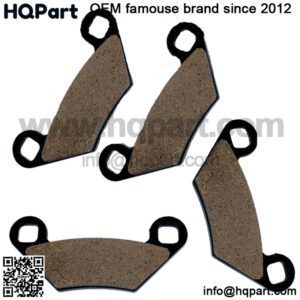Signs The Pads On Your Brakes Need Changing
There are a number of telltale signs you should look and listen for that will let you know when the brake pads should be changed. If you notice one or more of these signs, it means you should change the worn pads on your brakes right away or your car’s braking system will no longer function properly.
Continuing to drive your car will mean that you are compromising the safety, health and lives of you, your passengers and people with whom you share the road daily. Six signs the brake pads should be changed right away are:
1. Squeaking
2. Grinding
3. Vibration When Braking
4. Taking Longer To Stop
5. Indicator Light Comes On
6. Brake Pads Appear To Be Thin
Don’t ignore these signs or you can find yourself in danger of being in collisions that can cause property damage, serious injury or death.
What Each Of These Signs Means
Each of the 6 signs mentioned above are clues to the state of your brake pads. It can alert you to why you must take action right away to replace them. Here is a closer look at each sign and why immediate action is required.
1. Squeaking Brakes
Your brakes are metal discs tightly sandwiched between two brake pads. When you step on your brake pedal, the brake pads apply pressure against the metal discs. Many brake pads have steel clips that serve as wear indicators.
When your brakes begin to make squealing or squeaking noises it usually indicates that the brake pads have worn down below their safe limits and must be changed at the first opportunity or your vehicle will not stop in a timely manner when you step on the brake pedal. Ignore the squealing sound and you risk doing serious damage to your rotors that’s very expensive to repair.
2. Grinding Brakes
If every time you step on your brake pedal you hear a loud grinding sound, it often means the brake pads are so badly worn that the rotor disc is making contact with the caliper. Extremely worn brake pads can grind down and cut into your rotors. This can create a major brake system problem if it isn’t addressed right away.
When your brake pads start grinding against your rotors, it can result in damage to the rotors and the calipers and can cause your brakes to fail and be unable to stop your vehicle. If you hear a grinding sound when you mash your brakes, change your brake pads immediately.
3. Vibration When Braking
When the brake pads are overly worn, they can begin scraping metal off of the rotors in different spots. When the rotor is thinner in some spots than others, it can cause the brakes to shake or pulse when you step on the brake pedal.
When you notice this happening, it means you have to change the brake pads and have your rotors machined to make them a uniform thickness throughout. If you don’t do this quickly, your braking system will begin to have major problems and could eventually fail altogether. This vibration is a signal that the brake pads should be changed and your rotor repaired.
Important to note: At Kadotani Auto Repair, we typically will replace rotors rather than resurface them. Thin rotors tend to warp quickly after repair due to their inability to properly dissipate heat.
4. Taking Longer To Stop
Worn brake pads is a common reason a vehicle would take much longer than it normally does to come to a complete stop when you step on the brake pedal. When a vehicle’s brake pads are spent and should be changed, they are unable to put enough pressure on the rotors to quickly stop the wheels from turning.
This can be very dangerous because in situations where you need your vehicle to stop right away to prevent an accident or stop it from hitting a person or pet, your braking system won’t engage quickly enough. That’s why changing the brake pads in a timely manner is so important.
5. The Brake Indicator Light Comes On
Usually when the brake indicator light comes on it means the brake pads are spent or the brake fluid level is too low. Some newer vehicles have sensors that trigger the brake indicator light when the brake pads wear thin. Plus, spent brake pads can result in low brake fluid levels.
When brake pads are threadbare, they cause the brake caliper piston to extend further to force the brake pad to press up against the rotor. When the piston advances further, the space created inside the brake caliper fills with brake fluid. When the master cylinder’s brake fluid level drops dangerously low the light comes on.
6. Brake Pads Appear To Be Thin
For the braking system on your automobile to function properly, the brake pads should not be allowed to get thinner than ¼ inch. Brake pad thickness plays an essential role in road safety. Brake pads that measure 1⁄8 inch in thickness have reached the end of their recommended wear limit.
Driving with brake pads that thin is not safe. When a car’s brake pads start to appear to be very thin, then immediately change them. The brake pads on any car should be no thinner than 1⁄3 of an inch in order for them to be able to stop the vehicle quickly and safely. Change all very thin brake pads right away to protect yourself and others and prevent dangerous braking problems.
“Keyword”
“how to replace brake pads on ez go golf cart”
“changing brakes on golf cart”
“how to replace brake pads volkswagen golf”
“how long do golf cart brakes last”
“replacing brakes on golf cart”

